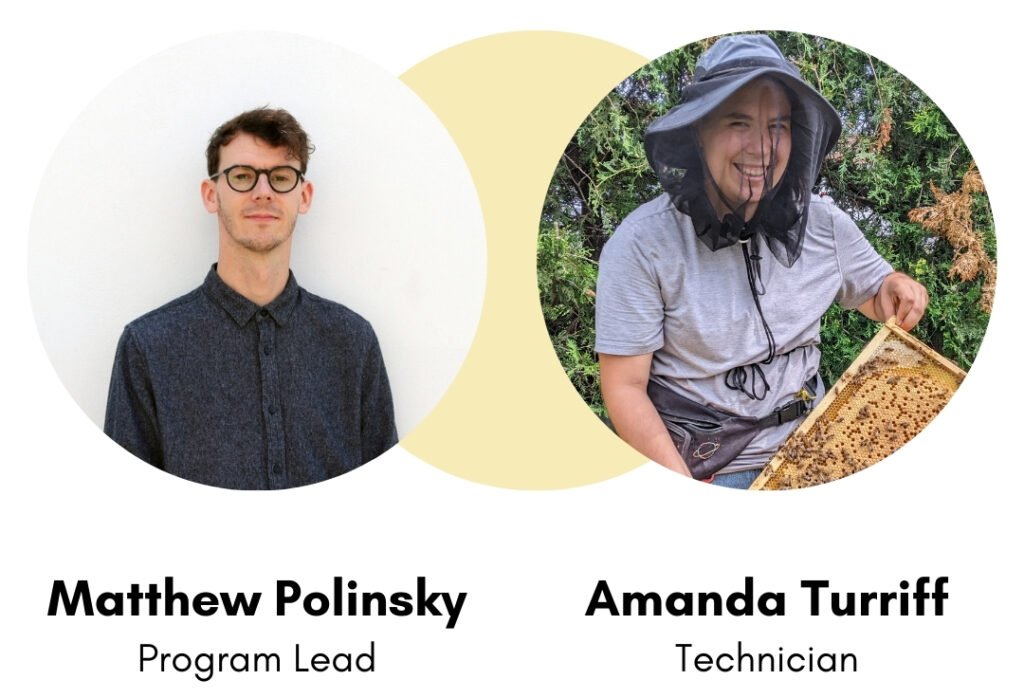🐝 Updates on ongoing research projects
📅 Announcements about upcoming events
📖 Reviews of recent scientific studies
🌿 Observations from the field throughout the season
📸 Photos capturing the joy and labour of each season
To get us started, we would simply like to include a portion of KRTP Winter Report that was published in the Manitoba Beekeeper 2025 Winter Newsletter, as it provides a refresher on the program’s mandate and status, along with notes on recent work.
Firstly, here we are, the KRTP Team:

Please visit the about page to learn more about us as well as the program history and status
Short version of the KRTP Winter Update 2025
By: Matthew Polinsky
This winter marks the completion of my second season with the KRTP as Program Lead, and the program itself is now entering its third year of a five-year funding period. In order to best serve the beekeeping community and secure future funding, it’s vital that we maintain momentum and balance within the program as each year builds on the preceding one. My responsibility is to ensure that we continue to fulfill all the key metrics in our Sustainable Canadian Agricultural Partnership funding agreement and meet the expectations of the apiculture community.
An essential component of our strategic planning is the annual KRTP Steering Committee meeting. This meeting serves to realign program priorities and develop strategies in accordance with the evolving needs of beekeepers and collaborators, which include researchers and industry partners. More broadly, this meeting provides oversight and centres the priorities of the MBA membership. As I become more familiar with the MB community, and with the previously mentioned directions guiding the KRTP forward, I constantly look to beekeepers to understand your challenges and interests. Our ongoing conversations and your engagement with the KRTP play a vital role in shaping the program as it evolves year after year.
Before highlighting a few of the major activities undertaken this past year, I’d like to take a moment to remind the membership of the program’s core purpose.
The KRTP mandate was conceived with four pillars: i) education, ii) services to beekeepers, iii) applied research, and iv) communication. The KRTP focuses on honey bee health, integrated pest management strategies, best management practices for local conditions, community engagement, and overall betterment of the beekeeping industry. To support Manitoba beekeepers in maintaining optimal bee health and productivity the KRTP mission includes, but is not limited to, the following:
- Contribute to filling knowledge gaps between research and real-world application.
- Develop and share knowledge and practices that reflect shifting environmental, biologic, and economic conditions. The end goal is to make sure beekeepers are aware of the most up-to-date information that they can benefit from adopting.
- Facilitate connections between the beekeeping community and apicultural researchers to advance science and practice.
2024/2025 Research Update
Varroa Control Product from GreenLight Biosciences
We completed a second year testing GreenLight Bio’s varroa treatment, Norroa™. Standardizing the mite levels in our trial colonies helped the trial go smoothly and we produced clear data on its efficacy in 2024. As of writing this report, we are putting together a presentation of the results. As is common in corporate product development, our non-disclosure agreement prevents us from sharing the results in a publication at this time. However, we’re excited to present the full details of our methods and results at the convention this February. The KRTP’s rigourous and independent testing of this product will provide a credible local source of information for beekeepers. For GreenLight Bio, Canadian efficacy data is critical for the registration process with Canada’s Pest Management and Regulation Agency (PMRA). If you would like to learn about the mode of action of the active ingredient (vadescana) you can find a detailed explanation in the October 2024 issue of the American Bee Journal. In short, it prevents the production of offspring of the varroa mite – thereby reducing the mites’ ability to build up the population. This approach will complement existing mite control products that target the phoretic adult mites and should reduce the amount of feeding on the developing bee larvae.
2024/2025 Winter Project: Evaluating the Efficacy and Safety of Oxalic Acid Glycerin Extended-Release Strips (Varroxsan)
Oxalic acid (OA) is used in a variety of ways depending on the applicator type, excipient, dosage, number of applications, timing of treatments, etc. While OA glycerin extended-release strips are not yet a registered method of varroa control (the CHC submitted an application for registration with PMRA in 2024), there’s a need to continually learn about the most effective and practical approaches for using this method in our region.
The KRTP is partnering with Dr. Sarah Wood and Dr. Alvaro de la Mora Peña from the University of Saskatchewan to conduct an experiment using oxalic acid glycerin strips in an indoor wintering environment, focused on efficacy and safety. The study targets the underutilized broodless—or near-broodless—treatment window during the winter months. Instead of inserting the strips in the fall and allowing five months of potentially positive or negative effects to impact colonies, the controlled study will explore a mid-winter application, allowing for more precise evaluation of outcomes. Phil Veldhuis has generously provided 78 colonies for this experiment that we have been preparing since August 2024, doing evaluations and attempting to retain sufficient mite levels through winter without causing excessive damage to the hives. We need mites present to test in order to test a control method!
We’ve got more research and extension project ideas in the works for 2025 that we look forward to sharing with you soon.


